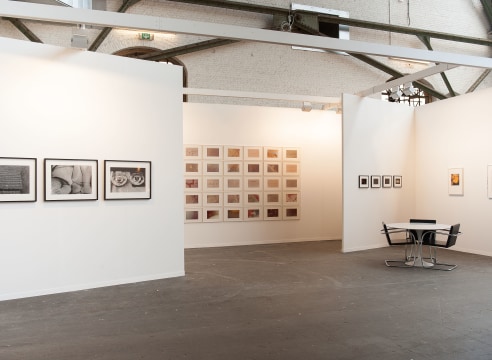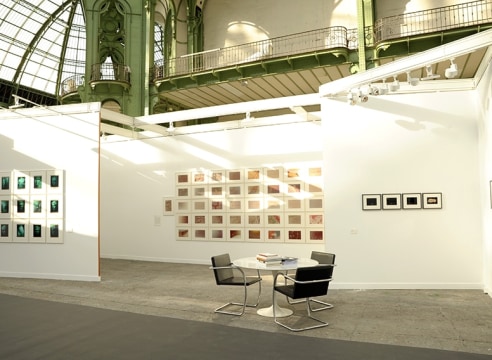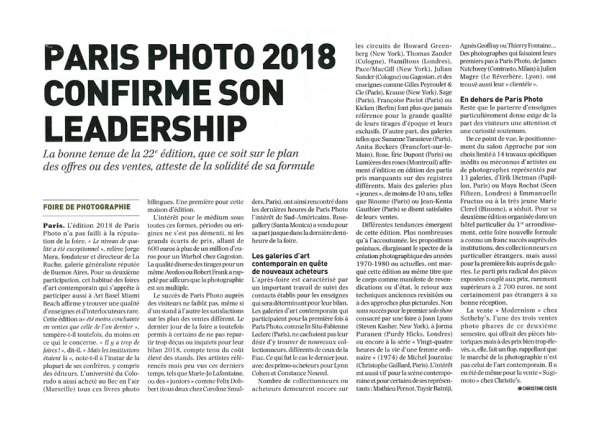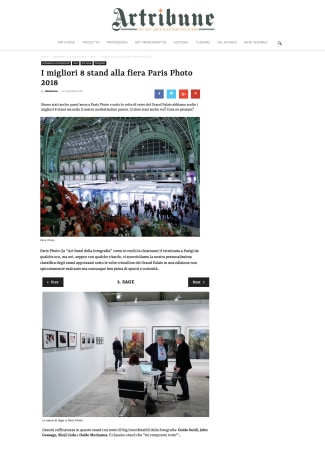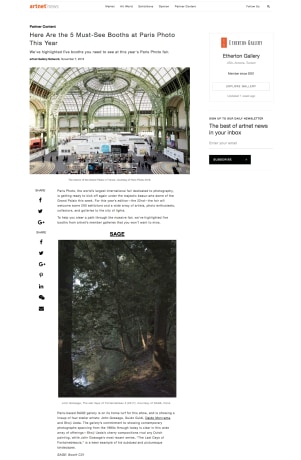
Shoji Ueda est un artiste majeur de la photographie japonaise, dont l’œuvre a rapidement connu un retentissement international. Ses compositions, inventives et pleines de charme, sont à part dans l’histoire de la photographie, détachées des modes et des mouvements artistiques, purs produits de son esprit ludique et de son imagination fertile. Dans les dunes, chères à son cœur, de sa région natale de Tottori, mais également dans les rues de son village ou chez lui, il crée toujours, guidé par sa vision unique et son insatiable curiosité, des images à l’esthétique frappante, oniriques et d’un humour bienveillant.
Auprès de sa famille posant pour lui, d’enfants des écoles environnantes, de mannequins dans les années 1980, il orchestre des compositions surprenantes, à la fois graphiques et très poétiques. Le modèle, en soi, compte moins que la silhouette, le contraste, la construction de l’image, l’incongruité des objets et des corps. De même, au sein de son atelier, dans le creux d’une petite boîte, il arrange et coordonne ses objets, bouts de bois et coquillages ramassés sur le sable, objets du quotidien, ou fruits et légumes. À ces objets, tout comme aux portraits de ses proches ou aux photographies de mode, il confère la même tonalité « surréalisante », faisant naître la poésie des détails quotidiens, en marge de la tendance documentaire du Japon de son époque. Dans ses photographies même les objets, ainsi, acquièrent quelque chose d’humain et de comique, personnages intégrés à son monde, et regardant le spectateur avec une douce ironie.
En effet, une part importante de l’œuvre de Shoji Ueda réside dans son originalité assumée par rapport aux tendances et aux mouvements artistiques de son époque. Isolé dans sa région natale, il crée en se coupant des agences tokyoïtes et de la production artistique des grands centres de création japonais et mondiaux, n’ayant accès à des magazines sur la photographie que très rarement – notamment un exemplaire du journal suisse ‘’Modern Photography’’ au début de sa carrière, induisant un intérêt de courte durée pour l’avant-garde surréaliste. Il produit ainsi des images atypiques, dans cette région surnommée San’in (dans l’ombre de la montagne) -dans l’ombre de Tokyo. L’atmosphère si particulière de la région, avec une lumière de bord de mer, des ciels nuageux et mélancoliques, est la toile de fond de Ueda, dont il imprègne ses photographies, en tirant des gris subtils et lumineux. Accompagnant son traitement de la lumière, évidemment, on ne peut passer outre la dune, immense étendue de sable qui semble luminescente tant elle reflète la clarté du ciel, et dont Ueda se sert comme de la toile immaculée accueillant les projections de son imagination. « La dune est un paysage naturellement photographique. La nature réduite à un fond uni. Franchement, je ne crois pas qu’un photographe puisse rêver mieux qu’une dune. » Ces dunes qu’il utilise comme atelier lui permettent de simplifier au maximum l’arrière-plan, faisant ressortir le sujet, dans une esthétique précise fondée sur le dépouillement. La lumière si particulière trace ainsi des contours nets, qui concentrent le regard sur l’essentiel.
Par ses photographies évocatives, au sobre raffinement tout en retenue, il tente de montrer ce que l’œil ne voit pas habituellement, « La photographie est pour moi un art de représentation dans tous les sens du terme. Ma touche est d’intervenir et de concevoir sur place mon univers personnel. Montrer les choses telles qu’elles apparaissent à la plupart des gens ne m’intéresse plus aujourd’hui. Je leur laisse le monde documentaire et il m’importe d’essayer de leur suggérer qu’on peut voir autrement. » Il aménage ainsi la réalité, dans un désir d’assumer le caractère théâtral de la photographie, qui est toujours une mise en scène de la réalité dans le viseur. « J’aime bien que l’on sente une légère intervention du photographe dans les images. » Son regard d’une grande sincérité crée ainsi un dialogue complice avec le monde ; ses modèles d’une grande présence interpellent le spectateur, dans un regard assumé vers la caméra. Au théâtre d’objets s’ajoute le théâtre de marionnettes dans les dunes. Captant la simplicité du geste, son œuvre tend vers une harmonie essentielle entre les éléments, et aspire à rendre compte d’un temps suspendu, de calmes « mémoires silencieuses ». Cet univers décalé déjouant nos conventions visuelles, cette poésie du quotidien totalement personnelle, ce questionnement du temps qui met à distance le sujet en le rendant intemporel, cette universalité de l’humour et de la tendresse, il les fabrique avec une grande modestie, ne se considérant pas comme un photographe professionnel, mais un « photographe sérieux ».
Cette revendication de son statut d’amateur –notamment auprès des clubs amateurs de photographie - l’a également dispensé d’explications ou de manifestes, lui laissant une totale liberté de ton, et n’entachant pas ce qu’il considère comme une passion quotidienne qui est à la fois toute sa vie et dans laquelle il inscrit toute sa vie. Très rapidement propriétaire d’un magasin de matériel photographique, cette façade professionnelle banale cache en réalité un esprit d’une inventivité et d’une liberté incomparables. Dans son monde unique, fait de fantaisie, d’un sens aigu de l’observation, d’une certaine rigueur formelle, il déploie un humanisme doux, un sens unique de la communication –qui lui permet de se lier avec les nombreux enfants qu’il a photographiés, ainsi qu’une généreuse empathie envers le monde et les modèles qu’il en tire. Cette sensibilité, alliée à une vision épurée et synthétique, confère à son œuvre une fraîcheur toujours renouvelée, à l’instar de son regard d’enfant qui invente un univers en transcendant les bribes du quotidien le plus anodin.
Shoji Ueda est né en 1913 à Sakaiminato, dans le sud-ouest du Japon. Très jeune, il pense devenir peintre, et à 15 ans son père lui achète son premier appareil photographique. Il fera dès ses 18 ans partie de groupes de photographes amateurs, avant d’obtenir en 1932 le diplôme de la Tokyo Oriental Photography School. Jusqu’à sa disparition en 2000, il dédiera sa vie à la photographie dans sa région natale, loin de la profusion tokyoïte, dans un esprit d’esthète revendiquant son amateurisme, mais encensé internationalement comme un des principaux photographes japonais, auquel un musée à même été dédié en 1995, le Shoji Ueda Shashin Bijutsukan. Récemment, ses œuvres ont été exposées au Musée de l’Élysée (Lausanne, 1990), Tokyo Station Gallery (1993), Galerie municipale du Château d’Eau (Toulouse, 1994), Gallery Bodo Niemann (Berlin, 1999), Galleria Carla Sozzani (Milan, 1999), Howard Greenberg Gallery (New York, 2002), Tokyo Metropolitan Museum of Photography (2005), Fundacion La Caixa (Madrid, 2005), Musée de l’Élysée (Lausanne, 2006), Maison européenne de la Photographie (Paris, 2008).
Son œuvre est conservée dans les collections Du Shoji Ueda Museum of Photography (Tottori, Japan), Musée d’Art moderne (Paris).
Shoji Ueda is a major artist in Japanese photography, whose œuvre soon had an international stir. His compositions, inventive and charming, are aside from history of photography, far from artistic movements and tendencies, pure products of his playful spirit and his fertile imagination. In the close to his heart dunes of his native region of Tottori, but also in the streets of his village or at home, guided by his unique vision and his insatiable curiosity, he always creates images of a striking aesthetic, dreamlike and full of benevolent humour.
Alongside his family, kids of surrounding schools, professional models during the 1980’s, all posing for him, he orchestrates surprising compositions, both graphical and highly poetic. The model in itself matters less than the silhouette, the contrast, the construction of the image, the incongruousness of objects and bodies. Likewise, within his studio, inside a little box, he arranges and coordinates his objects; wood sticks and seashells picked up on the beach, objects of the everyday life, or fruits. To these, as well as to the portraits of his relatives and to the fashion photographs, he lends the same “surreal touch”, generating poetry within daily details, at the margins of the documentary tendency of his Japanese contemporaries. In his photographs even the objects acquire something human and comic, like characters he integrates to his world, looking at the viewer with sweet irony.
Indeed, a great part of Shoji Ueda’s oeuvre is characterized by his assumed originality beside the tendencies and artistic movements of his time. Isolated in his native region, he is cut from Tokyo’s agencies and from the production of great artistic centres in and out Japan, having an access to photography magazines quite rarely – notably one exemplary of the Swiss “Modern Photography” in the beginning of his career, inducing a short running interest for surrealism avant-garde in his work. He then produces atypical images, in this area called San’in (in the mountain’s shadow) – in the shadow of Tokyo. The peculiar atmosphere of the San’in, with its seashore light, its cloudy and melancholic skies, is Ueda’s backdrop, from which he likes to draw subtle and bright greys, impregnating his photographs with this ambiance. Beside his treatment of light one cannot, obviously, override the dune, immense stretch of sand which seems luminescent from reflecting the brightness of the sky, and used by Ueda as the immaculate canvas receiving the projections of his imagination. “The dune is a naturally photographic landscape. Nature reduced to a plain background. Frankly, I don’t think a photographer could dream of something better than a dune.” These dunes he uses as his studio enable him to simplify the background as much as possible, bringing the subject out, in a precise aesthetic based on bareness. The very peculiar light thus draws some very sharp outlines, which concentrate the gaze on what is essential.
Through his evocative photographs, of sober refinement, he endeavours to show what the eye doesn’t normally see ; “Photography is for me an art of representation in every sense of the word. My touch is to intervene and conceive on the spot my personal universe. To show things as they appear to most of the people is not interesting to me anymore. I leave the documentary world for them, and what matters to me is to try to suggest them that one can see differently.” He thus adapts reality, in a desire to assume the theatrical characteristics of photography, which is always a setting of reality in the lens. “I like when we feel a slight intervention of the photographer in the images.” His very sincere view creates an accomplice dialogue with the world; his models of great presence challenge the viewer, with an assumed gaze to the camera. To the theatre of objects must be added a puppet theatre in the dunes. Capturing the simple essence of the gesture, his oeuvre creates an essential harmony between the elements, and strives to express a suspended time made of quiet “silent memories’. He successfully builds a quirky universe foiling our visual conventions, a very personal poetry of the everyday life, a questioning about time, by distancing the subject and making it timeless, and a soothing universality of humour and tenderness. But he keeps a refreshing humility, and doesn’t consider himself as a professional photographer but a “serious photographer”.
This claim of this amateur status – notably alongside amateur clubs of photography - also dispensed him with explanations and manifests, giving him a complete freedom of tone, but without tarnishing what he considers a daily passion which is all of his life and in which he defines all his life. Soon the owner of a photographic material shop, this banal exterior hides in fact a spirit of incomparable inventiveness and freedom. In his unique world, made of fantasy, of a sharp sense of observation, of a certain formal rigour, he deploys a tender humanism, a unique sense of communication – which enables him to connect with the numerous children he photographed, and a generous empathy with the world and the models he draws from it. This sensitivity, together with a refined and synthetic vision, lend to his work an always renewed freshness, his eyes being just like those of a child, inventing a world by transcending the fragments of the most innocuous everyday life.
Shoji Ueda was born in 1913 in Sakaiminato, in the south-west of Japan. Very young, he thinks of becoming a painter, and at fifteen years-old his father offers him his first camera. At eighteen years old he already belong to groups of amateur photographers, and in 1932 he graduates from the Tokyo Oriental Photography School. Until his disappearing in 2000, he dedicated his life to photography in his native region, far from Tokyo’s profusion, in an aesthete spirit which claims his amateurism. However, Shoji Ueda has been internationally praised as one of the leading Japanese photographer, to whom a museum has even been dedicated in 1995, the Shoji Ueda Shashin Bijutsukan (Shoji Ueda Museum of Photography).
Recently, his works have been exhibited in the Musée de l’Elysée (Lausanne, 1990), Tokyo Station Gallery (1993), Galerie municipale du Château d’Eau (Toulouse, 1994), Gallery Bodo Niemann (Berlin, 1999), Galleria Carla Sozzani (Milan, 1999), Howard Greenberg Gallery (New York, 2002), Tokyo Metropolitan Museum of Photography (2005), Fundacion La Caixa (Madrid, 2005), Musée de l’Elysée (Lausanne, 2006), Maison Européenne de la Photographie (Paris, 2008).
His work has been collected by public collections such as the Shoji Ueda Museum of Photogaphy (Tottori, Japan), and the Musée d’Art Moderne (Paris).








